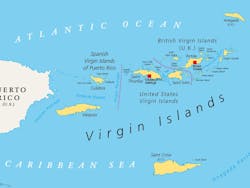A 28-MW microgrid project in the US Virgin Islands was awarded $4.4 million by the Federal Emergency Management Agency (FEMA) for the project’s initial phase.
The Virgin Islands Water and Power Authority (WAPA) will use the funding to design and engineer the project, according to Noel Hodge, the utility’s interim executive director.
WAPA expects FEMA will pay for the entire $129 million solar microgrid on western St. Croix, which will include a 10-MW/20-MWh battery storage system, Hodge said April 9.
“The solar plant and battery system will introduce a renewable source of energy, increase the reliability of the electric grid and provide dedicated service to customers on the western end of the island,” Hodge said.
When finished, the microgrid plus 4 MW of solar at another site will produce about half of St. Croix’s electricity, according to Hodge.
The St. Croix project and its funding grew out of Hurricane Irma and Hurricane Maria, which destroyed nearly the entire power system across the Virgin Islands in 2017. Hodge expects the microgrid project will be paid for through FEMA’s hazard mitigation grant program.
WAPA plans four microgrid projects
WAPA’s recovery plan also calls for building three microgrids on St. Thomas, St. John and Water Island as well as the one on St. Croix, according to a late February presentation by the utility to the US Virgin Islands’ Legislature’s Committee on Disaster Recovery and Infrastructure. The utility expects to start the projects next year and complete them in 2024.
Interested in microgrids? Join us for Microgrid 2021: The World Awakens to Microgrids, a virtual conference featuring 50 top experts and microgrid leaders, beginning May 11 and running for four weeks. Choose from among more than 20 panel discussions, workshops, webinars and interviews. Network and attend live Q&A sessions. Register now. Space is limited on the virtual platform.
The St. Thomas project includes 15 MW of wind and a 15-MW/30-MWh battery system. The Water Island project is 1.5 MW of solar with a 1-MW/2-MWh battery. St. John’s two-phase project could total 8 MW with 4-MW/16-MWh of battery capacity.
The water and power authority has about 50,000 customers.
Track news about island microgrids by subscribing to the free Microgrid Knowledge Newsletter.







